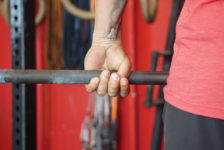
I’ve got good news and bad news. If you’re resisting the hook grip, it’s time to give up. When I say, “hook grip” I’m talking about the little natural hook you make with your hand by wrapping your fingers around the bar and your thumb, rather than the natural grip you’d make with your thumb outside your fingers. This natural hook is a key option for some weightlifting movements. The good news is that this creates a undisputable grip advantage in certain scenarios. The bad news is it’s uncomfortable the first twenty-seven times you use it or so. Get past this rough patch, though, and you’ve successfully set sail on a certifiably higher performing habit.
When does one use this rule of thumb? (Sorry, I had to.)
The answer is simple. Any Olympic lift (clean or snatch) variation that starts below the a waste. Cleans, hang cleans, power cleans, hang power clean, tall cleans, and the gambit of snatch variations are all fair game. Heavy pulls (deadlifts) with specific intended transfer to the clean or snatch are fair game, too.
When do you give up the hook grip?
Easy. The receiving position is a hook grip free zone. Got the bar on your shoulders? Overhead? Regular grip, please! If you love the hook grip and the tension in creates, you can maintain it at the shoulder or overhead. Maybe you like the pain, even. Knock yourself out, but that’s not required.
Weightlifting is one of the most geographically diverse sports in the world with as much representation from different countries as any sport. With endless styles, lifter sizes and shapes, and coaching methods, there’s not much competing countries agree on. Nonetheless, there are zero exceptions to the hook grip rule on the worldwide scene. Zero.
Don’t be the one.
Logan Gelbrich
@functionalcoach
2/1/17 WOD
Find a Heavy Single Box Squat
Complete 3 rounds for time of:
30 Alternating KB Swings (53/35)
30 Lateral Plyo Skier Hops (20″)

